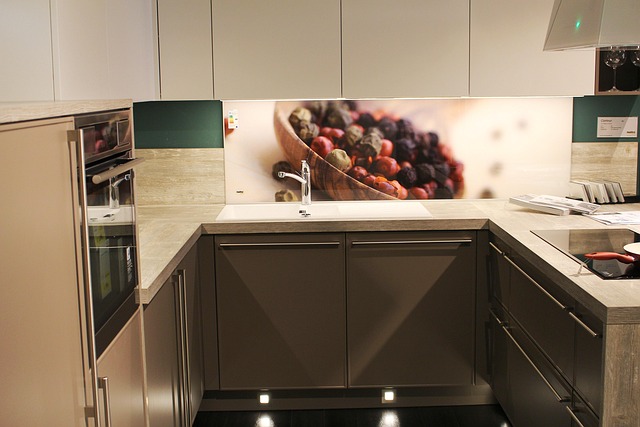Open kitchen-living spaces are a modern trend that integrates cooking and social areas seamlessly, fostering interaction and community. By eliminating walls or using half walls, these designs offer better visibility, natural light, and an inviting atmosphere for gatherings. Strategic placement of kitchen islands and countertops facilitates movement and conversation, while contrasting textures and lighting enhance both functionality and aesthetics. L-shaped or U-shaped floor plans maximize space and encourage mingling among guests, making open kitchens a central hub for family and social activities in today's bustling households.
Open kitchen-living spaces are revolutionizing modern homes, creating a vibrant hub for family and social gatherings. This article explores the benefits of merging these areas, enhancing connectivity and visibility while fostering a more inclusive lifestyle. We’ll guide you through key design considerations, popular floor plans, and practical tips to maximize this open layout’s potential, ensuring both functionality and aesthetic appeal in your dream kitchen-living space.
- Understanding the Benefits of Open Kitchen-Living Spaces
- Designing an Open Layout: Key Considerations for Functionality and Aesthetics
- Popular Open Kitchen Living Space Floor Plans
- Maximizing Visibility: Practical Tips for Optimal Kitchen Integration
Understanding the Benefits of Open Kitchen-Living Spaces
Open kitchen-living spaces have gained immense popularity in recent years due to their numerous benefits and the way they transform our daily lives. This design concept seamlessly blends the culinary heart of a home—the kitchen—with the comfort and social ambiance of the living area, creating an inviting and functional environment. By eliminating walls or using half walls, these open layouts allow for better visibility, facilitating easier communication between cooks in the kitchen and those relaxing in the living room.
This arrangement also promotes a more interactive lifestyle, encouraging family and friends to gather and engage in conversations while enjoying delicious meals. Moreover, open kitchen-living spaces maximize natural light, creating a bright and welcoming atmosphere that enhances overall well-being. This design choice is especially advantageous for modern households where entertaining guests and fostering social connections are highly valued.
Designing an Open Layout: Key Considerations for Functionality and Aesthetics
When designing an open layout, particularly for a combined kitchen and living space, functionality and aesthetics must go hand in hand. The primary goal is to create a seamless transition between these areas while ensuring optimal visibility and interaction. One key consideration is the placement of the kitchen island or countertop seating. Strategically positioning these elements allows for easy flow during meal preparation and creates a natural gathering spot within the open space.
Aesthetically, open layouts offer opportunities to play with materials, colors, and lighting. Incorporating contrasting textures, such as sleek countertops alongside rustic wood cabinets, adds visual interest. Lighting fixtures can enhance both functionality and ambiance; hanging pendant lights over an island or using recessed lighting beneath upper cabinets ensures a well-lit cooking environment while setting the mood for social gatherings in the living space.
Popular Open Kitchen Living Space Floor Plans
In today’s modern homes, an open kitchen living space has become a popular choice for many. This design philosophy emphasizes seamless connectivity between the kitchen and surrounding areas, such as the dining room or family room. Popular floor plans often feature an L-shaped or U-shaped kitchen layout, allowing for ample counter space and easy access from all angles. These open concepts facilitate better visibility and communication among family members, especially during meal preparation and social gatherings.
Many homeowners opt for these layouts due to their ability to foster a sense of community and reduce the isolation often associated with traditional closed kitchens. The open kitchen living space design also lends itself well to entertainment, as it provides a central hub where guests can mingle while the host prepares meals. This flexibility in spatial arrangement has made open kitchen-living spaces a true game-changer in today’s bustling households.
Maximizing Visibility: Practical Tips for Optimal Kitchen Integration
In an open kitchen living space, maximizing visibility goes beyond aesthetics; it’s about creating a functional environment that facilitates seamless interaction between cooking and social areas. To achieve this, strategically place countertops at eye level to serve as visual anchors for both the kitchen and adjacent spaces. This ensures that whoever is preparing meals can easily engage with guests or family members in nearby areas, fostering a sense of connection and accessibility.
Additionally, utilize ambient lighting effectively. Recess lights, pendant fixtures, and under-cabinet lighting not only illuminate the workspace but also contribute to the overall visual flow. Keep color palettes neutral or complementary to avoid distractions and maintain an airy, open feel. By combining thoughtful design with practical lighting and surface choices, you can create an inviting atmosphere where visibility enhances both culinary experiences and social connections within your open kitchen living space.
An open kitchen-living space offers a modern, welcoming ambiance, enhancing social interactions and improving family dynamics. By incorporating these design principles and practical tips, you can create an inviting environment that seamlessly blends functionality with aesthetics. Whether it’s a vibrant, bustling kitchen at the heart of your home or a more subtle integration, maximizing visibility through open layouts allows for better connection, easier meal prep, and a truly beautiful culinary experience.
